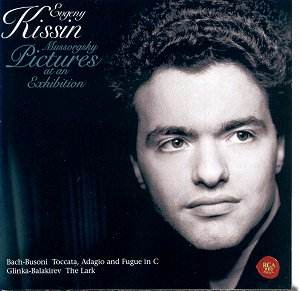Recordings by Evgeny Kissin are always eagerly awaited.
On paper, this programme should work well: the Mussorgsky is true virtuoso
fare; the Bach/Busoni is born out of the Romantic tradition; the Glinka/Balakirev
from the self-same Russian line as the Mussorgsky.
The Bach/Busoni of 1900 is an enormous conception (nearly
twenty minutes long). One cannot but admire the technical aspects of
Kissin’s performance: the sterling fingerwork; the clear laying-out
of part-writing. Yet it was Busoni himself that referred to this work
as ‘majestic, rich in feeling and bold’ and Kissin does indeed miss
the grandeur inherent in this piece. Fortes can be harsh (there is a
subito forte around 5’17 which is just uncomfortable), and the
effect is highlighted by the bright recording. The Fugue is the best,
with an impressive build-up to the climax, almost as if Kissin wanted
the listener to forget the Toccata and the Adagio.
Kissin certainly seems more at home in the Balakirev’s
arrangement of Glinka’s song, ‘The Lark’ (the arrangement dates from
around 1864, and was revised in 1900): the treble is limpidly and affectingly
projected and there is real delicacy here. It is not unfair to say that
this five-minute piece provides the highlight of the disc.
I have covered Mussorgsky’s Pictures at an Exhibition
for the ‘Seen and Heard’ section of this site a couple of times over
the last season: Pletnev played it quirkily recently at the Royal Festival
Hall in March 2002; Andreas Boyde at the Wigmore gave a considered reading
in November 2001. Kissin’s reading is cumulative in effect (and possibly
in intent). The opening ‘Promenade’, however (and hence the ‘possibly’)
is too quick to contain any great import (it has too much of a spring
in its step). ‘Tuileries’ needs more wit, not a quality one readily
associated with this pianist. ‘Il vecchio castello’, however, is hypnotic
and gives a hint of some of the things to come later in Kissin’s interpretation,
and later on the ‘Market Place in Limoges’ appropriately bustles with
life while ‘Catacombs’ is boldly stated. ‘The Hut on Fowl’s Legs (Baba-Yaga)’
is truly impressive: so much so, in fact, that it rather overshadows
the ‘Great Gate’. If it is Pictures you are after, save a few
pennies and go to the incomparably greater Sviatoslav Richter on the
mid-price Philips 464 734-2.
Colin Clarke


